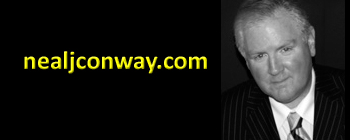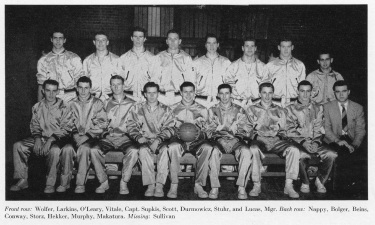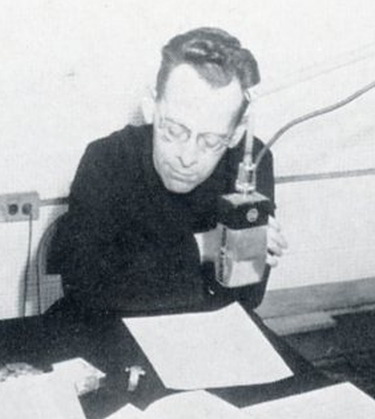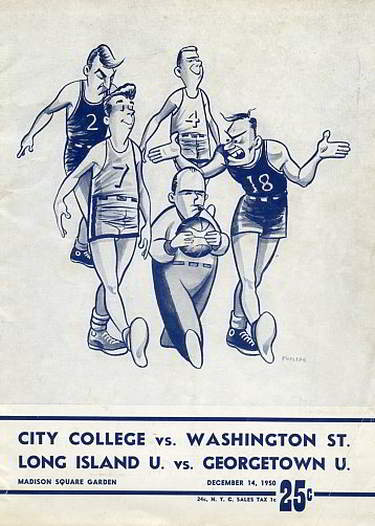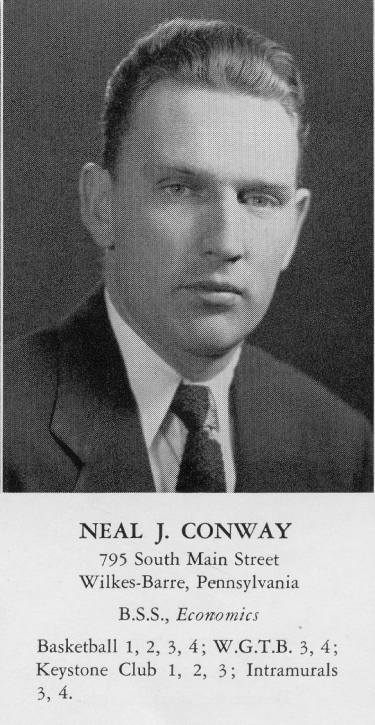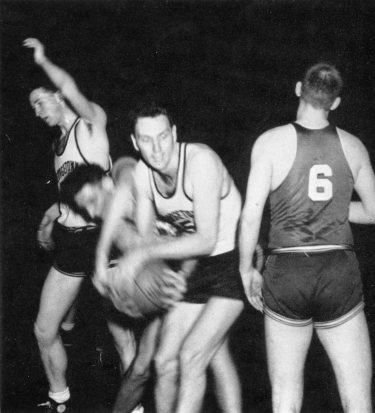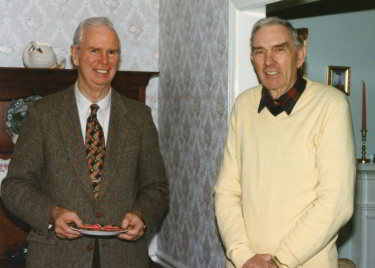AUTOBIOGRAPHY
Pops Conway's Georgetown Basketball Scholarship
May 19, 2019
Part I: How He Got It
The letter addressed to my father, Neal Conway at 99 N. Main St. in Ashley, Pennsylvania was dated April 18, 1949. "I have been following your progress in basketball with great interest this year," the letter's writer, a J. J. Movern, informed Dad, "and I am wondering whether you would be interested in attending our University next fall."
"Our University" was Georgetown. Although the letter hinting at a basketball scholarship was sent, not from the Georgetown address at 37th & O Streets but from an address on the corner of Newark Street and Wisconsin Ave., an apartment building called The Abby. Nor was the letter on Georgetown University letterhead. Nevertheless my father, in a May 2 response, returned the requested answered questionnaire and a photo of himself. Thus began a four-month frustrating adventure toward obtaining a Georgetown basketball scholarship.
The stack of letters I found after my father's death tell an incomplete story that I heard nothing of while Dad was alive. Frankly I, not having the basketball gene, was never curious about my father's hoops career. Thus, after 70 years what exactly happened in that episode that changed the course of my parents' lives and brought them to Washington, DC, where I was born and raised, will likely always be a mystery in this life.
"...I am wondering what your affiliation is with Georgetown."
At the end of those four months, my father wrote in a letter complaining to Georgetown Assistant Dean Rev. Lawrence R. McHugh, S.J.: "I suppose you wonder why I should annoy you with all the details in this letter. They probably seem incredible, and well they may, for they could never do justice to the actual trouble this scholarship has caused me....I am wondering how many other fellows have been put through the same nonsense."
Did the "nonsense" involve typical Catholic-institution dysfunction and incompetence? Was someone trying to make money by connecting potential students with scholarships? Was the "nonsense" a bit of both? Was Georgetown hungry for consistency in winning seasons and casting a broad net for players who could deliver them?
In the spring of 1949 my father was 24 years old and married almost a year. He had served in the U.S. Army Air Corps in World War II. Back home in Pennsylvania, he drifted from employer to employer in electricity-related jobs. He worked for Bell Telephone in Lancaster, installed the runway approach lights at Avoca Airport near Scranton. Until recently the steel-girder structure for those lights loomed over I-81 at the airport exit. Dad went to barber school. When the letter kicking off the Georgetown adventure arrived, he was working for the Wilkes-Barre Transit Company and playing on its basketball team.
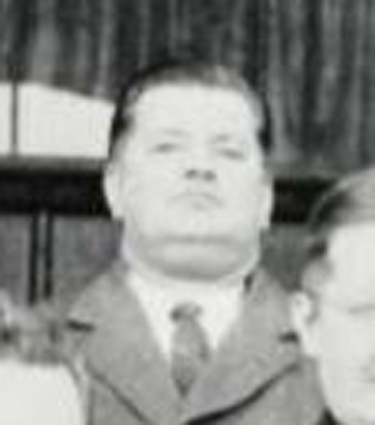
John J. Movern, Georgetown's business manger of athletics, whose motive in contacting my father about a scholarship is a mystery.
In 1949 most Americans neither went to college nor saw a college degree as a must-have ticket to a good living. Indeed since the 1920s college had been depicted in popular culture as a playground for rich kids. My Mom, a straight-A student at St. Leo's High, turned down scholarships to college and became an administrative assistant. She figured that college was a dead end for women and went to a secretarial school instead. Newly married to my Dad in 1949, she had a good job in the front office of the Hazard-Okonite cable-making company in Wilkes-Barre.
However the G.I. Bill of Rights for World War II veterans such as my Dad inspired him and many of his fellow vets to consider college when they otherwise would not have. The G.I. Bill gave $500/year for college tuition. At most colleges, tuition was not much more than $500 a year. In 1949 Georgetown probably cost on the high side of $1000.00. And that was with room and board.
Because G.I. Bill benefits would not fully cover tuition at a university like Georgetown, I can only imagine how excited and eager my parents became when the possiblity was raised of attending the great university on a scholarship. Those were times when blue-collar folks like my parents lived the words of a Bing Crosby song: You can be better than you are! You can be swingin' on a star!
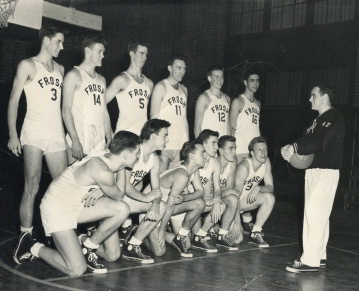
Georgetown's tall 1949 Frosh team juxtaposed against assistant coach James "Miggs" Reilly who, at only 5'6" was a Hoya basketball legend of earlier seasons. Neal Conway is the eager-looking No. 11.
The mysterious Mr. Movern
Much happened in the month after the arrival of J.J. Movern's letter. My father received from Movern an application to Georgetown and returned it. He got St. Leo's High School to forward his transcript and apparently took a college entrance exam. The correspondence with J. J. Movern came from and went to the Newark Street address, not from and to Georgetown.
Part of the mystery is how a J.J. Movern in Washington, DC came to be "following [my father's] progress in basketball." How did Movern learn about the performance of a guy who played for high school, company and town teams 200 miles from the Nation's Capital? Dad's prowess in basketball and baseball was occasionally noticed in the Wilkes-Barre paper. But that could be said of a zillion other guys in Northeastern Pennsylvania.
In his letters Movern did not indicate any positon he had with Georgetown. My father clearly was suspicious. In a May 17th letter to Movern Dad wrote:
In your letter of May 9, 1949, you stated that I should feel free to question you on any matters concerning my entrance into Georgetown University. There are a few things about which I would like some information.
First of all, I am wondering what your affiliation is with Georgetown.
As it turns out, John J. Movern, mentioned occasionally in Georgetown University publications from the 1950s and '60s, was the business manager of Georgetown's athletic department. But while a business manager may have had something to do with scholarships, why would a business manager be soliciting applicants and hinting that they could attend Georgetown on scholarships?
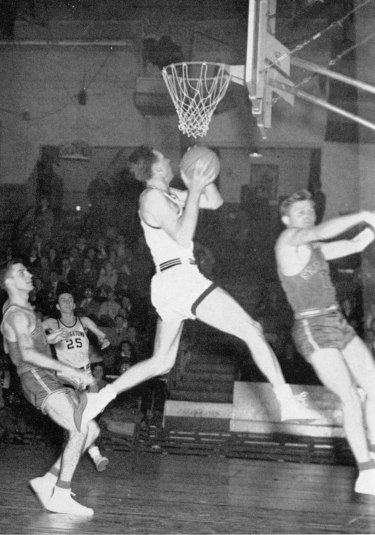
Neal Conway scores his only 2 points in his only Varsity game, against St. Francis of Loretto at Uline Arena.
My father's May 17 letter continued:
Also you probably read on my application that I am married. I would like to know if there is any way I can supplement my government allowance [G.I. Bill].
The next preserved letter from Movern, dated June 2, 1949, is on Georgetown University Department of Athletics letterhead. In it Movern writes that Georgetown's basketball coach, Elmer Ripley, who was "very interested" in my Dad's basketball record, is "no longer connected with the university." Movern informs my father that he would now have to contact and get approval from the new coach, Francis O'Grady at an address in Staten Island, NY. Note that Francis "Buddy" O'Grady was a New Yorker.
My father, in his letter of complaint to Fr. McHugh, recounted how he wrote to Coach O'Grady twice, "but he never even acknowledged my letters."
In late June my father had a phone conversation with Movern who followed up with a July 1 letter from the Newark St. address. Movern wrote:
I have discussed your case with the Basketball Coach and he is hesitant in making a final decision for several reasons. First of all, it is noted that you wish to major in Chemistry which course would prevent you from participating in athletics....the policy has been to have the athletes register for the Bachelor of Social Science course....Chemistry involves considerable laboratory time which comes in the afternoon and interferes with basketball practice.
It has also been brought to my attention that you are married which may make a difference in your future plans. [GU does not have housing facilities for students and their wives.] Housing has always presented quite a problem in Washington and you will find it extremely difficult to find accomodations near the university. Furthermore, with basketball occupying...five months time and studies nine months, the responsibilities that are a part of marriage cannot be met satisfactorily.
I have learned through experience that a married student does not have the time to participate in athletics, study and hold down a part-time job, the latter being especially necessary.
Despite the above my Dad spoke with Movern on the phone on July 9, 1949 and Movern assured him that he had O'Grady's approval.
Several children?
Also on July 9th Georgetown Assistant Dean McHugh sent a letter to Dad writing that he was "happy to inform you that your application for admission to our college of Arts and Sciences has been approved by the Committee on Admissions. You have been awarded a place in the Freshman class--" Information For New Students was enclosed.
Let's pause to reflect on how short the college application timeline was. My father received the letter from Movern about a Georgetown scholarship in April. By July he had been accepted by the university.
I don't know how joyful my parents were over that acceptance letter for it arrived in a thickening fog of confusion and frustration. Fr. McHugh makes no mention of a scholarship in the letter. Apparently while the letter was in transit, my father traveled to Washington, likely on buses that took all day to meander from and to Northeastern Pennsylvania, and visited Georgetown's campus. He met his correspondent John J. Movern and records that he was "shown around the campus, treated with the utmost courtesy and departed with the words 'see you in September' ringing in my ears."
Following on the heels of the acceptance letter was another from Movern's Newark St. address. Movern wrote:
After talking to you in Washington, I had intended to secure Coach O'Grady's permission [Had Movern not told my father on the phone on July 9th that he had O'Grady's approval?] to place your name on our scholarship list....However I have since received information that will prevent my assisting you further. It has been brought to my attention this afternoon that you have several children....
My parents only ever had one child and he was born 12 springs after 1949.

